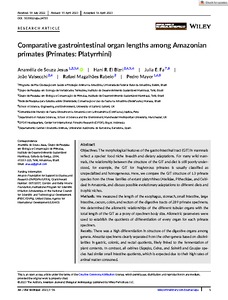Jesus, ADS, El Bizri, HR, Fa, JE 
![[img]](https://e-space.mmu.ac.uk/632039/1.hassmallThumbnailVersion/American%20Journal%20of%20Biological%20Anthropology%20-%202023%20-%20Jesus%20-%20Comparative%20gastrointestinal%20organ%20lengths%20among%20Amazonian-2.pdf)
|
Published Version
Available under License Creative Commons Attribution. Download (3MB) | Preview |
Abstract
Objectives: The morphological features of the gastrointestinal tract (GIT) in mammals reflect a species' food niche breadth and dietary adaptations. For many wild mammals, the relationship between the structure of the GIT and diet is still poorly understood, for example, the GIT for frugivorous primates is usually classified as unspecialized and homogeneous. Here, we compare the GIT structure of 13 primate species from the three families of extant platyrrhines (Atelidae, Pitheciidae, and Cebidae) in Amazonia, and discuss possible evolutionary adaptations to different diets and trophic niches. Methods: We measured the length of the esophagus, stomach, small intestine, large intestine, cecum, colon, and rectum of the digestive tracts of 289 primate specimens. We determined the allometric relationships of the different tubular organs with the total length of the GIT as a proxy of specimen body size. Allometric parameters were used to establish the quotients of differentiation of every organ for each primate specimen. Results: There was a high differentiation in structure of the digestive organs among genera. Alouatta specimens clearly separated from the other genera based on dissimilarities in gastric, colonic, and rectal quotients, likely linked to the fermentation of plant contents. In contrast, all cebines (Sapajus, Cebus, and Saimiri) and Cacajao species had similar small intestine quotients, which is expected due to their high rates of animal matter consumed. Conclusions: We show that diverse adaptations in digestive structure exist among frugivorous primates, which in turn reflect different dietary patterns within this group that may enable the geographic coexistence of different primate species.
Impact and Reach
Statistics
Additional statistics for this dataset are available via IRStats2.



